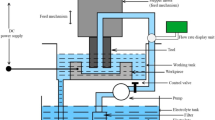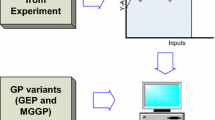Abstract
Design of the die in hot metal forming operations depends on the required forming load. There are several approaches in the literature for load prediction. Artificial neural networks (ANNs) have been successfully used by a few researches to estimate the forming loads. This paper aims at using the effectiveness of a new evolutionary approach called gene expression programming (GEP) for the estimation of forging load in hot upsetting and hot extrusion processes. Several parameters such as angle (α), L/D ratio (R), friction coefficient (µ), velocity (v) and temperature (T) were used as input parameters. The accuracy of the developed GEP models was also compared with ANN models. This comparison was evidenced by some statistical measurements (R 2, RMSE, MAE). The outcomes of the study showed that GEP can be used as an effective tool for representing the complex relationship between the input and output parameters of hot metal forming processes.



Similar content being viewed by others
References
Yang DY, Choi Y, Kim JH (1991) Analysis of upset forging of cylindrical billets considering the dissimilar frictional conditions at two flat die surfaces. Int J Mach Tools Manuf 31:397–404
Khelifi H, Perrot A, Lecompte T, Rangeard D, Ausias G (2013) Prediction of extrusion load and liquid phase filtration during ram extrusion of high solid volume fraction pastes. Powder Technol 249:258–268
Arif AFM, Sheikh AK, Qamar SZ, Al-Fuhaid KM (2007) Variation of pressure with ram speed and die profile in hot extrusion of aluminum-6063. Mater Manuf Processes 16:701–716
Joardar H, Sutradhar G, Das NS (2012) FEM simulation and experimental validation of cold forging behavior of lm6 base metal matrix composites. J Miner Mater Charact Eng 11:989–994
Rao TB, Krishna AG (2012) Design and optimization of extrusion process using FEA and Taguchi method. Int J Eng Res Technol 1(8):1–5
Fereshteh-Saniee F, Fakhar N, Karimi M (2013) Experimental, analytical, and numerical studies on the forward extrusion process. Mater Manuf Processes 28:265–270
Guan Y, Zhang C, Zhao G, Sun X, Li P (2012) Design of a multihole porthole die for aluminum tube extrusion. Mater Manuf Processes 27:147–153
You-Feng H, Shui-sheng X, Lei C, Guo-jie H, Yao F (2009) FEM simulation of aluminum extrusion process in porthole die with pockets. Trans Nonferrous Met Soc China 20:1067–1071
Paltasingh UC, Sahoo SK, Dash PR, Nayak KC, Potnuru S (2013) FEM Analysis and experimental investigation for lateral extrusion of hexagonal head. Int J Eng Res Appl 3:1265–1271
Ambrogio G, Gagliardi F (2012) Design of an optimized procedure to predict opposite performances in porthole die extrusion. Neural Comput Appl 23:195–206
Teimouri R, Baseri H (2013) Forward and backward predictions of the friction stir welding parameters using fuzzy-artificial bee colony-imperialist competitive algorithm systems. J Intell Manuf 26(2):307–319
Ashhab MS, Breitsprecher T, Wartzack S (2012) Neural network based modeling and optimization of deep drawing—extrusion combined process. J Intell Manuf 25(1):77–84
Hsiang S, Kuo J, Yang F (2006) Using artificial neural networks to investigate the influence of temperature on hot extrusion of AZ61 magnesium alloy. J Intell Manuf 17:191–201
Hsiang S, Kuo J (2004) Applying ANN to predict the forming load and mechanical property of magnesium alloy under hot extrusion. Int J Adv Manuf Technol 26:970–977
Lucignano C, Montanari R, Tagliaferri V, Ucciardello N (2009) Artificial neural networks to optimize the extrusion of an aluminium alloy. J Intell Manuf 21:569–574
Kareem A, Jawwad A, Barghash MA (2013) Evaluating the effects of process parameters on maximum extrusion pressure using a new artificial neural network-based (ANN-based) partial-modeling technique. Int J Adv Manuf Technol 68:2547–2564
Bin J, Liang G, Guang-jie H, Pei-dao D, Jian W (2008) Effect of extrusion processing parameters on microstructure and mechanical properties of as-extruded AZ31 sheets. Trans Nonferrous Met Soc China 18:160–164
Kaviti AK, Pathak KK, Hora MS (2009) Application of neural networks in preform design of aluminium upsetting process considering different interfacial frictional conditions. Pattern Recognit Mach Intell. doi:10.1007/978-3-642-11164-8_17
Toros S, Ozturk F (2010) Flow curve prediction of Al–Mg alloys under warm forming conditions at various strain rates by ANN. Appl Soft Comput 11:1891–1898
Bingöl S, Ayer Ö, Altinbalik T (2014) Extrusion load prediction of gear-like profile for different die geometries using ANN and FEM with experimental verification. Int J Adv Manuf Technol 76:983–992
Raj KH, Sharma RS, Srivastava S, Patvardhan C (1999) Modeling of manufacturing processes with ANNs for intelligent manufacturing. Int J Mach Tools Manuf 40:851–868
Ayer Ö, Bingöl S, Altinbalik T (2015) Artificial neural network modeling of injection upsetting load. Appl Mech Mater 729:155–160
Ergur HS, Oysal Y (2013) Estimation of cutting speed in abrasive water jet using an adaptive wavelet neural network. J Intell Manuf 26:403–413
Gandomi AH, Alavi AH (2012) A new multi-gene genetic programming approach to nonlinear system modeling. Part I: materials and structural engineering problems. Neural Comput Appl 21(1):171–187
Gao L, Xiao M, Shao X, Jiang P, Nie L, Qiu H (2012) Analysis of gene expression programming for approximation in engineering design. Struct Multidiscip Optim 46(3):399–413
Gandomi AH, Alavi AH (2011) Applications of computational intelligence in behavior simulation of concrete materials. Comput Optim Appl Eng Ind 359:221–243. doi:10.1007/978-3-642-20986-4_9
Gandomi AH, Tabatabaei SM, Moradian MH, Radfar A, Alavi AH (2011) A new prediction model for the load capacity of castellated steel beams. J Constr Steel Res 67(7):1096–1105
Gandomi AH, Alavi AH, Mirzahosseini MR, Nejad FM (2010) Nonlinear genetic-based models for prediction of flow number of asphalt mixtures. J Mater Civ Eng 23(3):248–263
Brezocnik M, Gusel L (2004) Predicting stress distribution in cold-formed material with genetic programming. Int J Adv Manuf Technol 23(7–8):467–474
Yang Y, Li X, Gao L, Shao X (2013) A new approach for predicting and collaborative evaluating the cutting force in face milling based on gene expression programming. J Netw Comput Appl 36(6):1540–1550
Gandomi AH, Alavi AH, Asghari A, Niroomand H, Nazar AM (2013) An innovative approach for modeling of hysteretic energy demand in steel moment resisting frames. Neural Comput Appl 24:1285–1291
NieL GaoL, Li P, Li X (2013) A GEP-based reactive scheduling policies constructing approach for dynamic flexible job shop scheduling problem with job release dates. J Intell Manuf 24(4):763–774
Azamathulla HM (2012) Gene expression programming for prediction of scour depth downstream of sills. J Hydrol 460:156–159
Zakaria NA, Azamathulla HM, Chang CK, Ghani AA (2010) Gene expression programming for total bed material load estimation—a case study. Sci Total Environ 408(21):5078–5085
Abdellahi M, Bahmanpour M, Bahmanpour M (2014) Laminating; the best way to improve Charpy impact energy of nanocomposites. Ceram Int 40(10):16115–16125
Onen F (2014) Prediction of scour at a side-weir with GEP, ANN and regression models. Arab J Sci Eng 39(8):6031–6041
Gandomi AH, Roke DA (2015) Assessment of artificial neural network and genetic programming as predictive tools. Adv Eng Softw 88:63–72
Author information
Authors and Affiliations
Corresponding author
Ethics declarations
Conflict of interest
The authors declare that they have no conflict of interest.
Rights and permissions
About this article
Cite this article
Bingöl, S., Kılıçgedik, H.Y. Application of gene expression programming in hot metal forming for intelligent manufacturing. Neural Comput & Applic 30, 937–945 (2018). https://doi.org/10.1007/s00521-016-2718-5
Received:
Accepted:
Published:
Issue Date:
DOI: https://doi.org/10.1007/s00521-016-2718-5




